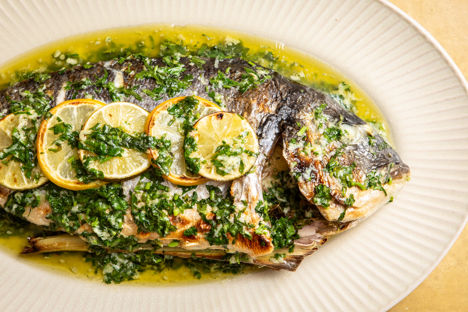Cooking fish on the barbecue can be tremendously rewarding, and is a little more special than simply grilling burgers and sausages. Served whole or in fillets, there are a range of different fish that suit the smoky, robust flavour that comes from barbecuing - in fact, if you take care over cooking, practically any fish can be cooked in this way.
What fish can you cook on the barbecue?
You can cook all sorts of different fish on the barbecue, but it’s important to make sure you match the right technique with the right fish. If using a barbecue with wide-set grill bars, cooking small, delicate fish fillets will be very tricky indeed, unless you wrap them in foil or place them in a fish basket.
A finer mesh-type grill will make it easier to cook fish fillets, but always remember Nathan Outlaw’s advice: only cook fish on a very high heat and oil the fish prior to cooking so that the skin doesn’t tear. Cleaning the grill rack and lightly oiling it before cooking will also help prevent sticking.
If cooking fillets directly on the grill, choose fish where the skin and flesh is fairly robust and can stand up to the heat - think salmon, halibut or monkfish. Make sure the skin of any fish that you use for this method is generously oiled and seasoned with salt – this helps to prevent sticking and gives the skin a wonderfully crisp, tasty finish.
A good way of cooking more delicate fillets, such as sea bass or plaice, is to wrap them in foil with a splash of liquid and aromatic herbs. This helps to protect the flesh and lightly steams the fish during cooking, ensuring you have wonderfully moist flesh.
What fish can you cook whole on the barbecue?
One of the best and most simple ways of barbecuing fish is to leave them whole - a whole sea bass or bream makes an impressive main, and the bones help to impart flavour and moisture into the flesh. Sardines, mackerel, trout or red mullet are generally the best fish for cooking whole. Not only are they affordable and widely available, they also suit a lot of tasty rustic flavours and don’t require too much preparation.
Leaving them whole also allows you to stuff the cavities, a wonderful way to add more flavour to the flesh of the fish. To help keep the stuffing inside the fish, and the flesh intact, fish baskets are one of the most handy gadgets you can buy for the barbecue season. These are made up of two attachable, metal racks (often in the shape of a fish) that you then place directly onto the barbecue. The heat that travels through the metal also gives nice char lines as they are in direct contact with the skin of the fish. You can also wrap whole fish in tin foil, which will add moisture but not produce a crispy skin.
How to barbecue a whole fish
Set up the barbecue for direct cooking
Stuff the lemon slices and herbs inside the cavities of the fish. Make several slashes in the sides of each fish and season with sea salt
Oil a piece of kitchen paper, then use tongs to rub this lightly over the grill bars (you don’t want oil to drip, but just to oil the grates)
Place the whole fish on the barbecue, either in a fish cage or directly onto the grill, and allow to cook until the skin of the fish naturally releases itself from the grill. This will take 4-5 minutes. Don’t try to move the fish before it releases itself as the skin will stick
Turn the fish over and cook the other side until the internal temperature of the fish reaches 63°C
Marinades, sauces and sides
Marinating fish for the barbecue is a great way to impart an extra kick of flavour - try a simple drizzle of oil with a few herbs and finish with a squeeze of lemon juice. In general, barbecued fish suits the classic flavours such as lemon, garlic, chilli, basil or thyme - avoid overpowering flavours that will mask the delicate taste of the fish.
For something a little different, fish can be marinated, diced and threaded onto skewers to form fish kebabs or used to make burgers - a particularly good trick for making fish more appealing to young children.
Flavoured butters can be a good option, and can be used to both stuff the fish before cooking or baste it while it cooks - try chive butter, tarragon butter, parsley butter or butter flavoured with lemon zest.
What can you serve with marinated fish?
A selection of sauces, relishes and sides go beautifully with barbecued fish. Salsa verde, tartare sauce, tomato mayo, citrus mayo, sweet chilli dip or avocado dip are all great options. Simply grilled vegetables such as tomatoes, courgettes and peppers or citrus-dressed salads also make worthy accompaniments.
Get in touch
Please sign in or register to send a comment to Great British Chefs.


